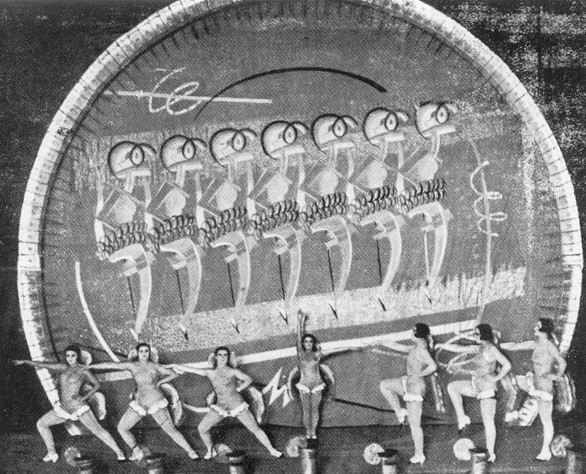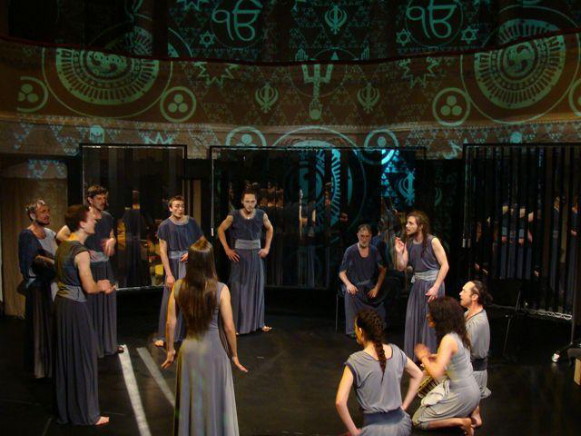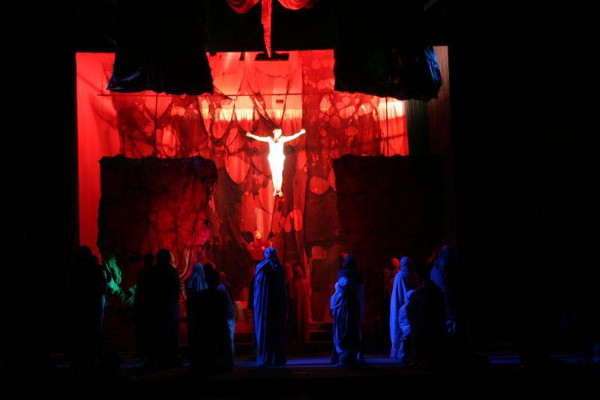Scenery, theatrical
Scenery, theatrical (сценографія; stsenohrafiia). Elements of scenery and costume design in Ukrainian theater were present in vertep puppet plays and in the productions of school drama in the 17th and 18th centuries. Painted backdrops were used in serf theaters from the late 18th century, and in amateur and professional touring theaters, from the middle of the 19th century. The Ruska Besida Theater employed Kornylo Ustyianovych, Vladyslav Ploshevsky, Friedrich Pohlmann, and Petro Diakiv as scenery painters. The scenery for Mykhailo Starytsky’s troupe was prepared under the supervision of the ethnographer Fedir Vovk. Marko Kropyvnytsky himself was responsible for scenery in his troupe and demanded that it be made according to illustrations by the historian Aleksandr Rigelman. The designers at Sadovsky's Theater in Kyiv were Vasyl H. Krychevsky and Ivan Buriachok, who began producing three-dimensional scenery. During the revolutionary years Mykola Burachek, Ivan Kavaleridze, and Kostiantyn Yeleva worked for agitprop theaters. Anatol Petrytsky was the designer for a number of Les Kurbas’s productions at Molodyi Teatr, where he created interesting sets for the vertep and for Sophocles’ Oedipus Rex. During the 1920s Vadym Meller’s constructivist approach to scenery and costumes at Berezil resulted in strong designs for Kurbas’s productions of Georg Kaiser’s Gas I (1923) and Jimmie Higgins (1923, based on Upton Sinclair’s novel). Meller also led a design labororatory at Berezil, where he trained such designers as Dmytro Vlasiuk, Ye. Tovbin, V. Shkliaev, and Mytrofan Symashkevych. Constructivism also influenced scenery designs by M. Matkovych, Yurii Pavlovych, Heorhii Tsapok, and Borys Kosariev. In opera, scenery by A. Petrytsky, Oleksander Khvostenko-Khvostov, and Ivan Kurochka-Armashevsky was used to highlight the costumes. From the mid-1930s, with the introduction of socialist realism, painted scenery once again dominated. Designers in Western Ukraine, however, (Leonyd Borovyk and Myroslav Radysh, for example), continued to work with more modernist techniques into the early 1940s. Notable designers of this period were Fedir Nirod, Yurii Stefanchuk, and Danylo Narbut. From the late 1950s, restrictions on scenery design were lessened, and some innovation was brought in (H. Batii and Myron Kypriian) and constructivism reappeared. Ukrainian scenery designers have also worked on foreign stages—Fedir Yakhymovych in the Imperial Opera in Vienna (1851–71), Mykhailo Andriienko-Nechytailo in the Royal Opera in Bucharest (1923), Vasyl Perebyinis and Mykola Krychevsky in Paris, and Oleksander Klymko in Buenos Aires, Washington, and New York.
BIBLIOGRAPHY
Khmuryi, V. Anatolii Petryts’kyi: Teatral'ni kostiumy (Kyiv 1929)
Drak, A. Ukraïns’ke teatral’ne-dekoratsiine mystetstvo (Kyiv 1961)
Verykivs’ka, I. Khudozhnyk i stsena (Kyiv 1971)
———. Stanovlennia ukraïns’koï radians’koï stsenohrafiï (Kyiv 1981)
Valeriian Revutsky
[This article originally appeared in the Encyclopedia of Ukraine, vol. 4 (1993).]

.jpg)
%20(stage%20design%20by%20A%20Petrytsky).jpg)
%20(stage%20design%20by%20A%20Petrytsky).jpg)


.jpg)